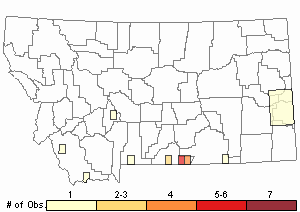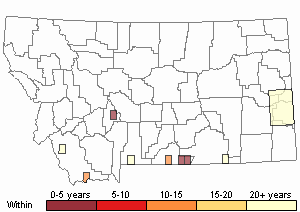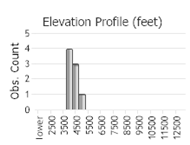View in other NatureServe Network Field Guides
NatureServe
Montana
Utah
Wyoming
Idaho
Wisconsin
British Columbia
South Carolina
Yukon
California
New York
Short-spine Horsebrush - Tetradymia spinosa
State Rank Reason (see State Rank above)
Tetradymia spinosa occurs in Montana on the northern edge of its distribution. Since 1900 Tetradymia spinosa has been included in the major floras for Montana (Rydberg 1900, Booth 1966, Dorn 1984, Lesica et al. 2012); yet, herbarium specimens are relatively few and the vast majority of observation data is more than 25 years old. In Beaverhead County its presence is documented by a single 1888 herbarium specimen and a 2013 observation with few informational details. Based on available information, this shrub grows in a common habitat type (sagebrush steppe) where populations are often small and widely scattered. In general, seedlings of Tetradymia species have been observed as rare, partially due to durations where flowers are not produced, germination is poor, and establishment rates are low (Strothers 1974). Surveys that bring forth better mapping and information on locations, population sizes, viability, reproduction, habitat, threats, and ecology are greatly needed.
- Details on Status Ranking and Review
Range Extent
ScoreF - 20,000-200,000 sq km (~8,000-80,000 sq mi)
Comment38,954 square kilometers.
Number of Populations
ScoreB - 6 - 20
Comment13 observations: 5 (1936-1963), 8 (1976-2019).
Environmental Specificity
ScoreC - Moderate. Generalist or community with some key requirements scarce
Intrinsic Vulnerability
ScoreAB - Highly to moderately vulnerable
CommentIn general, Tetradymia is described as having low fecundity due to failure in germination and establishment that may be attributable to the severity of environment and may be closely tied to precipitation (Strother 1974).
General Description
PLANTS: Shrubs that grow to 100 cm tall. Stems are spiny, tomentose, and highly branched. Source: Lesica et al. 2012
LEAVES: Alternately arranged on stems. Primary leaves are converted to spines about 1 cm long. Secondary leaves grow in fascicles [born on a short shoot in the axil of the primary leaf]. Fascicled leaf blades are simple with smooth (entire) margins, linear in shape, lack hairs (glabrous), and 7–15 mm long. Source: Lesica et al. 2012
INFLORESCENCE: Yellow flowers occur in heads which grow from leaf axils. Involucre is cylindric to obconic, 8–12 mm high. Involucral bracts are 4 to 6 in number and tomentose. Heads consist of 4-6 disk florets (discoid) that are prefect (both sexes). Disk florets have a tube longer than the throat, petals of 7–12 mm long, pistil with a flattened, branched style, and a pappus of white capillary bristles. Fruit is an achene. Source: Lesica et al. 2012
Phenology
Shrubs flower from May to June (Strother 1974).
Diagnostic Characteristics
Montana has 2
Tetradymia species:
Short-spine Horsebrush -
Tetradymia spinosa, SOC
*Stems: Spiny.
*Flower Heads: Grow from leaf axils.
Gray Horsebrush -
Tetradymia canescens *Stems: Unarmed.
*Flower Heads: Grow in clusters (corymbiform) at tips of stems.
Possible look-alikes include yellow-flowered shrubs in the Sunflower (Asteraceae) Family:
Tetradymia - Horsebrush
*Flower Heads: Ray florets are absent
and pappus is of capillary bristles.
*Twigs: White-tomentose (hairy) with or without spines
andUpper Leaves are fascicled.
Artemisia - Sagebrush
*Flower Heads: Arranged in a raceme or panicle, involucral bracts in 4-7 unequal rows,
and pappus is absent.
*Leaves: Usually lobed, but some species with simple leaves.
Ericameria - Goldenbrush / Rabbitbrush
*Flower Heads: a) Ray florets are absent
and pappus is of capillary bristles, or b) Some ray florets are present.
*Twigs: a) White-tomentose (hairy) without spines
and upper Llaves are mostly not fascicled, or b) glabrous and greenish.
Chrysothamnus - Rabbitbrush
*Flower Heads: Ray florets are absent
and pappus is of capillary bristles.
*Twigs: Glabrate to puberulent
and leaves are resin-dotted.
Gutierrezia sarothrae - Broom Snakeweed
*Flower Heads: Arranged in flat-topped clusters (corymbiform), ray florets present,
and pappus is of jagged (erose) scales.
*Plants are short, often less than 30 cm tall.
Lorandersonia linifolia - Spearleaf Rabbitbrush, PSOC
*Flower Heads: Ray florets are absent
and pappus is of capillary bristles.
*Twigs: Mostly without hairs (glabrous), has a whitish epidermis,
and leaves lack glands.
Species Range
Montana Range
Range Descriptions

 Native
Native
Range Comments
Oregon to Montana south to California, Utah, and New Mexico (Lesica et al. 2012).
Observations in Montana Natural Heritage Program Database
Number of Observations: 21
(Click on the following maps and charts to see full sized version)
Map Help and Descriptions
Relative Density

Recency



 (Observations spanning multiple months or years are excluded from time charts)
(Observations spanning multiple months or years are excluded from time charts)
Habitat
Sagebrush steppe in the plains and valley zones of Montana (Lesica et al. 2012).
Across its range, shrubs grow in very sand soils between 850 and 2,400 meters in Alkali Sink, Shadscale Shrub, or rarely in Pinyon-Juniper Woodland habitats (Strother 1974).
National Vegetation Classification System Groups Associated with this Species
Shrubland
Arid - Saline Shrubland
Sagebrush Shrubland
Sparse and Barren
Sparse and Barren
Ecology
Horsebrush species are common, but seldom abundant in the arid landscapes of western North America (Strother 1974). Unlike certain Sagebrush (Artemisia species, Horsebrush species don't form dense, impenetrable stands. Often colonies consist of no more than a few hundred individuals, and commonly can be found in loose groups of 25 to 50 shrubs. Further local colonies tend to exhibit uniform morphology, probably because they represent the local breeding population.
PLANT PHYSIOLOGY
All Horsebrush species have primary and secondary leaves. Primary leaves grow on elongated shoots where as, secondary leaves are borne in fascicles that grow from the axils of primary leaves (Strother 1974). In Short-spine Horsebrush the primary leaves are spines, but in other Horsebrushes they can take on other anatomical forms. Primary leaves are relatively long-lived, up to a few months or up to several years for the spined species, like Short-spine Horsebrush. In the armed Horsebrush species, the transformation of primary leaves into spines is caused by growth of fibers that continue into the decurrent bases of the spines, but was not present with axial fiber tissues. Secondary leaves are short-lived, tending to dry-up and whither within a few weeks of development. The longevity of secondary leaves is correlated to the dryness of the habitat and relative specialization of the plants that bear them.
Reproductive Characteristics
Shrubs reproduce by seed.
FRUITS
Achene: Obconic in shape, 5-ribbed, 6–8 mm long, and densely minutely-hairy (puberulent).
FLOWERING
For Horsebrush species the onset of flowering correlates with the temporal distribution and amount of rainfall (Strother 1974). Within an individual Horsebrush shrub, flowering is highly synchronized (within 2 to 4 days) (Strother 1974). This level of synchronization is characteristic of other xerophytes within the Sunflower (Asteraceae) family. It is a strategy that allows the plant to reproduce quickly when the proper amounts of rainfall arrive. This synchrony is actually exhibited by the entire local colony of a given species.
POLLINATORS
Horsebrush shrubs are visited by a variety of pollinators, including moths, bees, flies, and beetles (Strother 1974). Fertility by pollination is generally high (Strother 1974).
GERMINATION and ESTABLISHMENT
In Strother's studies on Horsebrush shrubs, he found fertility to be high and pollinators to be abundant, yet seedlings were often not observed (Strother 1974). Strother surmised that this resulted in a low turn-over rate within colonies which contributed to the lack of variation found in individuals of the same colony. In extremely dry years, Strother observed that individuals and even whole colonies might not flower at all and others that flower do not produce fruit, and reasoned that the cause was from a lack of water. Further the lack of fruit production may be more limiting for the species than the rate of germination or establishment. In Montana, conditions that limit germination, establishment, and fruiting intrinsically reduce the plant's viability. Consequentially this can lead to small population sizes and low genetic diversity. Colonies may be highly sensitive to local selection pressures.
Stewardship Responsibility
Threats or Limiting Factors
STATE THREAT SCORE REASON
Reported threats to Montana's populations of Short-spine Horsebrush are currently assigned as unknown. The thick thatch developing from Cheatgrass (Bromus tectorum), Field Fluffweed (Filago arvensis), and Common Mullein (Verbascum thapsus) at one site is speculated as making it difficult for new Short-spine Horsebrush plants to establish (MTNHP Threat Assessment 2021). General droughty conditions are a potential threat to plants at all locations(MTNHP Threat Assessment 2021). Information is needed to quantify the threat type(s), severity, scope and timing.
References
- Literature Cited AboveLegend:
 View Online Publication
View Online Publication Lesica, P., M.T. Lavin, and P.F. Stickney. 2012. Manual of Montana Vascular Plants. Fort Worth, TX: BRIT Press. viii + 771 p.
Lesica, P., M.T. Lavin, and P.F. Stickney. 2012. Manual of Montana Vascular Plants. Fort Worth, TX: BRIT Press. viii + 771 p. MTNHP Threat Assessment. 2021. State Threat Score Assignment and Assessment of Reported Threats from 2006 to 2021 for State-listed Vascular Plants. Botany Program, Montana Natural Heritage Program, Helena, Montana.
MTNHP Threat Assessment. 2021. State Threat Score Assignment and Assessment of Reported Threats from 2006 to 2021 for State-listed Vascular Plants. Botany Program, Montana Natural Heritage Program, Helena, Montana. Rydberg, P. A. 1900. Catalogue of the Flora of Montana and the Yellowstone National Park. Memoirs of the New York Botanical Garden, Volume 1, pp 1-492. Issued February 15th. New York.
Rydberg, P. A. 1900. Catalogue of the Flora of Montana and the Yellowstone National Park. Memoirs of the New York Botanical Garden, Volume 1, pp 1-492. Issued February 15th. New York. Tweedy, Frank. 1888. Tetradymia spinosa specimen at NY-Barcode 02737078. New York Botanical Garden, New York, New York.
Tweedy, Frank. 1888. Tetradymia spinosa specimen at NY-Barcode 02737078. New York Botanical Garden, New York, New York.
- Additional ReferencesLegend:
 View Online Publication
View Online Publication
Do you know of a citation we're missing? Harvey, S.J. 1990. Responses of steppe plants to gradients of water soil texture and disturbance in Montana, U.S.A. Ph.D. Thesis. Bozeman, MT: Montana State University. 34 p.
Harvey, S.J. 1990. Responses of steppe plants to gradients of water soil texture and disturbance in Montana, U.S.A. Ph.D. Thesis. Bozeman, MT: Montana State University. 34 p. Lesica, P., M.T. Lavin, and P.F. Stickney. 2022. Manual of Montana Vascular Plants, Second Edition. Fort Worth, TX: BRIT Press. viii + 779 p.
Lesica, P., M.T. Lavin, and P.F. Stickney. 2022. Manual of Montana Vascular Plants, Second Edition. Fort Worth, TX: BRIT Press. viii + 779 p. Quire, R.L. 2013. The sagebrush steppe of Montana and southeastern Idaho shows evidence of high native plant diversity, stability, and resistance to the detrimental effects of nonnative plant species. M.Sc. Thesis. Bozeman, MT: Montana State University. 124 p.
Quire, R.L. 2013. The sagebrush steppe of Montana and southeastern Idaho shows evidence of high native plant diversity, stability, and resistance to the detrimental effects of nonnative plant species. M.Sc. Thesis. Bozeman, MT: Montana State University. 124 p. Taylor, K., T. Brummer, L.J. Rew, B.D. Maxwell. 2014. Bromus tectorum response to fire varies with climate conditions. Ecosystems 17(6): 960-973. http://dx.doi.org/10.1007/s10021-014-9771-7
Taylor, K., T. Brummer, L.J. Rew, B.D. Maxwell. 2014. Bromus tectorum response to fire varies with climate conditions. Ecosystems 17(6): 960-973. http://dx.doi.org/10.1007/s10021-014-9771-7
- Web Search Engines for Articles on "Short-spine Horsebrush"





